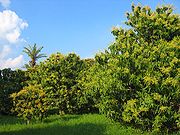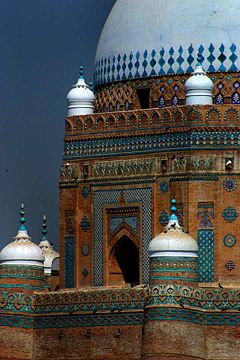
Climate of Multan
Encyclopedia

Multan
Multan , is a city in the Punjab Province of Pakistan and capital of Multan District. It is located in the southern part of the province on the east bank of the Chenab River, more or less in the geographic centre of the country and about from Islamabad, from Lahore and from Karachi...
is located in the southern part of Punjab
Punjab (Pakistan)
Punjab is the most populous province of Pakistan, with approximately 45% of the country's total population. Forming most of the Punjab region, the province is bordered by Kashmir to the north-east, the Indian states of Punjab and Rajasthan to the east, the Pakistani province of Sindh to the...
, province in Pakistan
Pakistan
Pakistan , officially the Islamic Republic of Pakistan is a sovereign state in South Asia. It has a coastline along the Arabian Sea and the Gulf of Oman in the south and is bordered by Afghanistan and Iran in the west, India in the east and China in the far northeast. In the north, Tajikistan...
.Multan features an arid climate with very hot summers and cold winters. The city witnesses some of the most extreme temperatures in the country.Dust storms are a common occurrence within the city. The closest major city is Bahawalpur
Bahawalpur
Bahawalpur , located in the province of Punjab, is the twelfth largest city in Pakistan. The city was once the capital of the former princely state of Bahawalpur. The city was home to various Nawabs and counted as part of the Rajputana states...
. The area around the city is a flat plain and is ideal for agriculture, with many citrus
Citrus
Citrus is a common term and genus of flowering plants in the rue family, Rutaceae. Citrus is believed to have originated in the part of Southeast Asia bordered by Northeastern India, Myanmar and the Yunnan province of China...
and mango
Mango
The mango is a fleshy stone fruit belonging to the genus Mangifera, consisting of numerous tropical fruiting trees in the flowering plant family Anacardiaceae. The mango is native to India from where it spread all over the world. It is also the most cultivated fruit of the tropical world. While...
farms. There are many canals that cut across the Multan District, providing water from nearby farms. This makes the land very fertile. However usually land close to the Chenab River are flooded in the monsoon season.
Factors
The monsoonMonsoon
Monsoon is traditionally defined as a seasonal reversing wind accompanied by corresponding changes in precipitation, but is now used to describe seasonal changes in atmospheric circulation and precipitation associated with the asymmetric heating of land and sea...
and the Western Disturbance
Western Disturbance
Western Disturbance is the term used in India, Pakistan, Bangladesh and Nepal to describe an extratropical storm originating in the Mediterranean, that brings sudden winter rain and snow to the northwestern parts of the Indian subcontinent. This is a non-monsoonal precipitation pattern driven by...
are the two main factors that change the weather over Multan; otherwise, Continental air prevails for rest of the seasons. Following are the main factors that influence the weather over Multan.
- Western Disturbances generally occurs during the winter months and causes moderate rainfall, sometimes Hail also occur.
- Fog do occur during the winter season and remains for three days to weeks. Foggy weather also results in closure of Multan Airport.
- Dust storm occur during summer months with peak in May and June. These dust storm are quite violent. Dust storms during summer indicates arrival of monsoon while dust storms in winter indicates the arrival of winter season.
- Heat waves occurs during May and June that causes stroke problems in the city.
- South West Monsoon also occurs in summer from the month of June till September. Monsoon rains bring much awaited relief from scorching heat. These monsoon rains are quite heavy by nature.
- Continental air prevails during the period when there is no precipitation in the city.
Seasonal Climate
Like all other cities, Multan also has four season which is Winter, Summer, Autumn and Spring. The monsoonMonsoon
Monsoon is traditionally defined as a seasonal reversing wind accompanied by corresponding changes in precipitation, but is now used to describe seasonal changes in atmospheric circulation and precipitation associated with the asymmetric heating of land and sea...
season also occurs in Summer.
Winter
The winter season begins from the month of December and last till February. Western DisturbanceWestern Disturbance
Western Disturbance is the term used in India, Pakistan, Bangladesh and Nepal to describe an extratropical storm originating in the Mediterranean, that brings sudden winter rain and snow to the northwestern parts of the Indian subcontinent. This is a non-monsoonal precipitation pattern driven by...
influence the winter season. The average lowest January temperature in the season of winter is 4.5 °C (40.1 °F). While the average highest temperature in winter was recorded in the month of December which is of 22.7 °C (72.9 °F). Heavy rains occur in winter which decrease the temperature further. Hailstorms also occur due to Western Disturbance
Western Disturbance
Western Disturbance is the term used in India, Pakistan, Bangladesh and Nepal to describe an extratropical storm originating in the Mediterranean, that brings sudden winter rain and snow to the northwestern parts of the Indian subcontinent. This is a non-monsoonal precipitation pattern driven by...
. The highest monthly rainfall in winter occurs in February that is 9.2 millimetre (0.362204724409449 in).
Spring

Summer
The summer season begins from May and last till September. Summer is the longest season of Multan. MonsoonMonsoon
Monsoon is traditionally defined as a seasonal reversing wind accompanied by corresponding changes in precipitation, but is now used to describe seasonal changes in atmospheric circulation and precipitation associated with the asymmetric heating of land and sea...
rains also occur in this season, these rains begin from June till September. Extremely high temperatures are recorded in summer. Violent dust storms occur in May and June while almost all the summer Loo
Loo (wind)
The Loo is a strong, hot and dry summer afternoon wind from the west which blows over the western Indo-Gangetic Plain region of North India and Pakistan. It is especially strong in the months of May and June...
blow that causes the traffic to remain thin. Heavy rains also occur during monsoon season. The highest average temperature recorded in Summer is recorded in June that is 42.3 °C (108.1 °F) while the lowest was recorded in September that is 24.9 °C (76.8 °F). Recorded-breaking highest temperature of 50 °C (122 °F) was recorded on 27 May 2010. The heaviest rainfall for Multan also occurred in summer on 8 August 2010 when 120 millimetres (4.7 in) of rain was recorded in 24 hour. While the most wettest month of summer is July as the highest average monthly rainfall is 62 millimetres (2.4 in).
Autumn
This season begins from October and ends in November. Hazy and dry weather is the main factor of Autumn. The highest average temperature was record in the month of October that is 34 °C (93.2 °F) and the lowest average temperature is 10.9 °C (51.6 °F)recorded in November. Showers do occur in this season late in November. The highest monthly average rainfall of Autumn is 2.1 millimetre (0.0826771653543307 in) recorded in the month of October.Heat Waves
Being close to Thar and RajasthanRajasthan
Rājasthān the land of Rajasthanis, , is the largest state of the Republic of India by area. It is located in the northwest of India. It encompasses most of the area of the large, inhospitable Great Indian Desert , which has an edge paralleling the Sutlej-Indus river valley along its border with...
deserts. Multan has seen some worst heat waves in the history of Pakistan
- In 1956, about 49 °C (120.2 °F) was recorded.
- In 2006, 47 °C (116.6 °F) was recorded that killed 33 people.
- In 2010, record-breaking heat wave was observed all over Pakistan, and in Multan fifty four year record was broken when temperature touched 50 °C (122 °F) on 27 May.
Monsoon Rainfall for Multan
The average monsoon rainfall for Multan is 119.7 millimetres (4.7 in), following is the monsoon rainfall of Multan since 2005;- In 2005, a total of 123 millimetres (4.8 in) rainfall was recorded.
- In 2005, a total of 124 millimetres (4.9 in) rainfall was recorded.
- In 2006, a total of 35 millimetres (1.4 in) rainfall was recorded.
- In 2008, a total of 70 millimetres (2.8 in) rainfall was recorded.
- In 2009, a total of 56 millimetres (2.2 in) rainfall was recorded.
- In 2010, a total of 227 millimetres (8.9 in) rainfall was recorded.
- In 2011, a total of 112.2 millimetres (4.4 in) rainfall was recorded.

